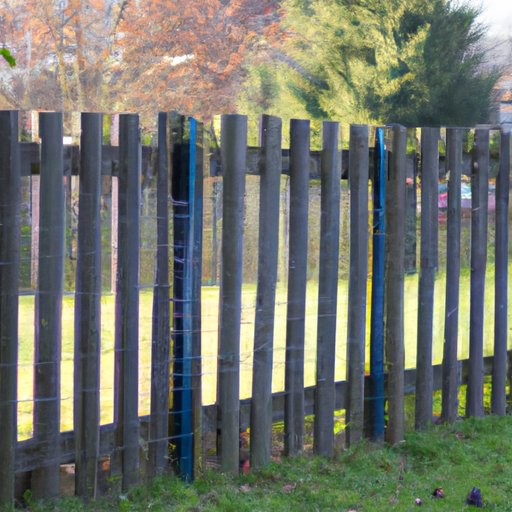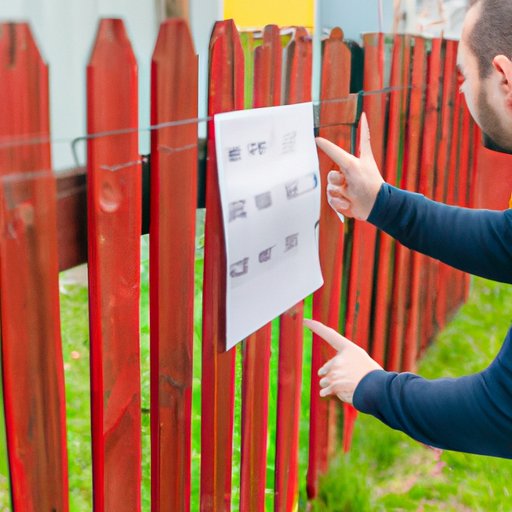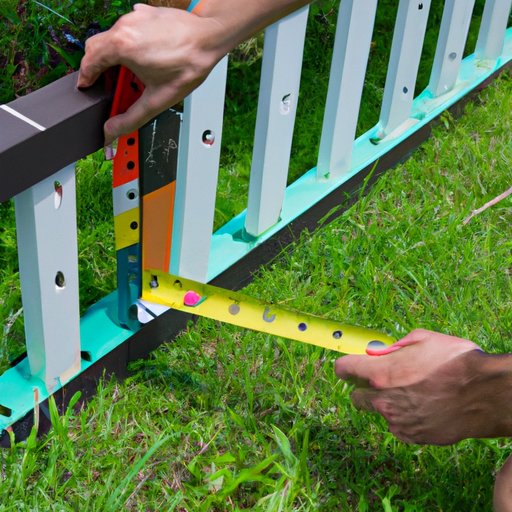Introduction
When it comes to protecting your property, building a fence is one of the most effective solutions. But what does it cost to build a fence?
The cost of building a fence varies depending on the type of material used, the size of the fence, and the complexity of the design. In this article, we will explore the various factors that affect the total cost of building a fence, as well as provide some tips on how to save money when building a fence.

A Comprehensive Guide to Fencing Costs
The first step in understanding the cost of building a fence is to consider the different types of fencing materials available. Each type of fencing material has its own associated cost.
Types of fences and associated costs
- Chain link: Chain link fencing is one of the most affordable options, with prices ranging from $8 to $20 per linear foot.
- Wood: Wood is another popular option, with prices ranging from $12 to $27 per linear foot.
- Vinyl: Vinyl fencing is more expensive than wood or chain link, with prices ranging from $17 to $35 per linear foot.
- Aluminum: Aluminum fencing is one of the most expensive options, with prices ranging from $25 to $40 per linear foot.
- Steel: Steel is the most durable and secure option, but it comes at a higher cost, with prices ranging from $30 to $50 per linear foot.
In addition to the cost of the fencing materials, there are several other factors that can affect the total cost of building a fence. These include labor costs, installation type, size, and location.
Additional factors that affect cost
- Labor: Labor costs vary depending on the complexity of the project and the experience level of the installer. Professional installers typically charge an hourly rate, while DIYers may be able to complete the installation for free.
- Installation type: The cost of installing a fence can vary depending on the type of installation. For example, installing a fence post-by-post is more time consuming and requires more materials than installing a panel system.
- Size: The size of the fence is also a factor in determining the total cost. Larger fences require more materials and labor, which increases the overall cost.
- Location: The location of the fence can also affect the total cost. Installing a fence in a remote area or on difficult terrain may require additional work and materials, which can increase the cost.
The True Cost of Building a Fence
When determining the true cost of building a fence, there are several cost considerations to take into account. The two most significant costs are usually the materials and labor.
Cost considerations
- Materials: The cost of materials depends on the type of fence being installed. As mentioned above, chain link is the most affordable option, while aluminum is the most expensive.
- Labor: Labor costs vary depending on the complexity of the project. Professional installers typically charge an hourly rate, while DIYers may be able to complete the installation for free.
- Permits: Depending on your local ordinances, you may need to obtain a permit before installing a fence. Check with your local building department to find out if a permit is required and the associated costs.
In addition to these costs, there are other factors that can impact the total cost of building a fence. These include the land size, location, design complexity, and material. The amount of land that needs to be fenced in will determine the amount of materials needed, which can drive up the cost. Location can also affect the cost, as fencing materials may be more expensive in certain areas. Finally, the complexity of the design and the type of material used can also affect the total cost of the fence.
How Much Does It Cost to Install a Fence?
The cost of installing a fence depends on several factors, including the type of fence, size, labor, and terrain.
Factors that impact installation costs
- Type of fence: The type of fence being installed will have an impact on the total cost. Chain link is generally the least expensive option, while aluminum is the most expensive.
- Size: The size of the fence will also affect the cost. Larger fences require more materials and labor, which can increase the total cost.
- Labor: Labor costs vary depending on the complexity of the project and the experience level of the installer. Professional installers typically charge an hourly rate, while DIYers may be able to complete the installation for free.
- Terrain: Installing a fence on difficult terrain can add to the total cost, as additional materials and labor may be required.
What Factors Impact the Cost of Building a Fence?
When determining the cost of building a fence, there are several factors to consider. Land size, location, design complexity, and material all play a role in the total cost.
Factors that influence cost
- Land size: The amount of land that needs to be fenced in will determine the amount of materials needed, which can drive up the cost.
- Location: Fencing materials may be more expensive in certain areas, so the location of the fence can also affect the total cost.
- Design complexity: The complexity of the design and the type of material used can also affect the total cost of the fence.
- Material: The type of material used will also have an impact on the cost. Chain link is generally the least expensive option, while aluminum is the most expensive.

Comparing Prices for Different Types of Fences
To get a better understanding of the cost of building a fence, let’s look at the cost comparison of different types of fences.
Cost comparison of different types of fences
- Chain link: Chain link fencing is one of the most affordable options, with prices ranging from $8 to $20 per linear foot.
- Wood: Wood is another popular option, with prices ranging from $12 to $27 per linear foot.
- Vinyl: Vinyl fencing is more expensive than wood or chain link, with prices ranging from $17 to $35 per linear foot.
- Aluminum: Aluminum fencing is one of the most expensive options, with prices ranging from $25 to $40 per linear foot.
- Steel: Steel is the most durable and secure option, but it comes at a higher cost, with prices ranging from $30 to $50 per linear foot.

Breaking Down the Cost of a Fence Installation
Installing a fence involves several steps, each of which can affect the total cost. Let’s take a look at the steps involved in installing a fence.
Steps in the fence installation process
- Pre-construction: Before beginning the installation, it’s important to prepare the site by clearing any debris and removing any existing structures in the way.
- Post hole digging: After the site is prepared, the next step is to dig post holes for the fence posts. This step can be time consuming and requires special tools.
- Setting posts: Once the post holes are dug, the posts must be installed. This typically involves mixing concrete and setting the posts in the holes.
- Installing panels: After the posts are set, the next step is to install the panels. This step requires attaching the panels to the posts using screws or nails.
- Finishing touches: The final step is to finish the fence with trim, caps, and other decorative elements.
Strategies for Saving Money When Building a Fence
Building a fence can be expensive, but there are ways to reduce the total cost. Here are some tips for saving money when building a fence.
Tips for saving money
- DIY installation: Installing a fence yourself can save you money, since you won’t have to pay for professional labor. However, it’s important to make sure you have the necessary tools and skills to properly install the fence.
- Shop around for materials: Shopping around for materials can help you find the best deals. Compare prices at different stores and online to find the lowest cost materials.
- Negotiate with contractors: If you decide to hire a professional installer, be sure to negotiate the price. Many contractors are willing to lower their rates if they know they’re competing with other contractors.
- Choose low-cost materials: Choosing lower-cost materials can help reduce the total cost of building a fence. Chain link is the least expensive option, while aluminum is the most expensive.
- Consider a partial fence: If you don’t need a full fence, you may want to consider a partial fence. This can be a cost-effective solution for smaller properties.
Conclusion
Building a fence can be an expensive endeavor, but there are ways to minimize the total cost. By understanding the different types of fencing materials and the factors that impact the cost, you can ensure that you get the most value for your money. Additionally, there are several strategies for reducing the total cost, such as DIY installation, shopping around for materials, negotiating with contractors, choosing low-cost materials, and considering a partial fence.
(Note: Is this article not meeting your expectations? Do you have knowledge or insights to share? Unlock new opportunities and expand your reach by joining our authors team. Click Registration to join us and share your expertise with our readers.)
